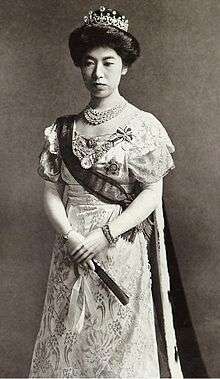Empress Teimei
| Empress Teimei 貞明皇后 | |||||
|---|---|---|---|---|---|
 | |||||
| Empress consort of Japan | |||||
| Tenure |
30 July 1912 – 25 December 1926 | ||||
| Enthronement | 10 November 1915 | ||||
| Born |
25 June 1884 Nishikichō, Tokyo City, Empire of Japan | ||||
| Died |
17 May 1951 (aged 66) Fukiage Ōmiya Palace, Tokyo, Japan | ||||
| Burial |
22 June 1951 Musashi Imperial Graveyard, Hachiōji, Tokyo, Japan | ||||
| Spouse | Yoshihito, Emperor Taishō | ||||
| Issue |
Hirohito, Emperor Shōwa Yasuhito, Prince Chichibu Nobuhito, Prince Takamatsu Takahito, Prince Mikasa | ||||
| |||||
| House | Imperial House of Japan | ||||
| Father | Michitaka Kujō | ||||
| Mother | Ikuko Noma (concubine) | ||||
| Religion | Shinto | ||||
Empress Teimei (貞明皇后 Teimei-kōgō, 25 June 1884 – 17 May 1951) was empress consort of Emperor Taishō of Japan. Born Sadako Kujō (九条節子 Kujō Sadako), she was the mother of Emperor Shōwa. Her posthumous name, Teimei, means "enlightened constancy".
Biography
Sadako Kujō was born on 25 June 1884 in Tokyo, as the fourth daughter of Duke Michitaka Kujō, head of Kujō branch of the Fujiwara clan. Her mother was Ikuko Noma.[1]
She married then-Crown Prince Yoshihito (the future Emperor Taishō) on 25 May 1900. The couple lived in the newly constructed Akasaka Palace in Tokyo, outside of the main Tokyo Imperial Palace complex. When she gave birth to a son, Prince Hirohito (the future Emperor Shōwa) in 1901, she was the first official wife of a Crown Prince or Emperor to have given birth to the official heir to the throne since 1750.
She became Empress (Kōgō) when her husband ascended to the throne on 30 July 1912. Given her husband's weak physical and mental condition, she exerted a strong influence on imperial life, and was an active patron of Japanese Red Cross Society. The relations between the Emperor and Empress were very good, as evidenced by Emperor Taishō’s lack of interest in taking concubines, thus breaking with hundreds of years of imperial tradition, and by her giving birth to four sons.
After the death of Emperor Taishō on 25 December 1926, her title became that of Dowager Empress (皇太后 Kōtaigō) (which means "widow of the former emperor"). She openly objected to Japan's involvement in World War II, which might have caused conflict with her son, Hirohito. From 1943, she also worked behind the scenes with her third son Prince Takamatsu to bring about the downfall of Prime Minister Hideki Tōjō.
She died on 17 May 1951 at Omiya Palace in Tokyo, aged 66, and was buried near her husband, Emperor Taishō, in the Tama no higashi no misasagi (多摩東陵) at the Musashi Imperial Graveyard in Tokyo.[2]
Titles and styles
| Styles of Empress Teimei | |
|---|---|
 | |
| Reference style | Her Imperial Majesty |
| Spoken style | Your Imperial Majesty |
| Alternative style | Ma'am |
- 25 June 1884 – 25 May 1900: Lady Sadako Kujō
- 25 May 1900 – 30 July 1912: Her Imperial Highness The Crown Princess
- 30 July 1912 – 25 December 1926: Her Majesty The Empress
- 25 December 1926 – 17 May 1951: Her Majesty The Empress Dowager
- Posthumous title: Her Majesty Empress Teimei
Honours
National honours
- Grand Cordon of the Order of the Sacred Treasure
- Grand Cordon of the Order of the Precious Crown
Foreign honours
- The 1,060th Dame of the Royal Order of Queen Maria Luisa
Issue
| Name | Birth | Marriage | Issue | |
|---|---|---|---|---|
| Hirohito, Emperor Shōwa | 29 April 1901 died, 7 January 1989 | 26 January 1924 | Princess Nagako of Kuni | Shigeko, Princess Teru Sachiko, Princess Hisa Kazuko, Princess Taka Atsuko, Princess Yori Akihito, Emperor of Japan Masahito, Prince Hitachi Takako, Princess Suga |
| Yasuhito, Prince Chichibu | 25 June 1902 died, 4 January 1953 | 28 September 1928 | Setsuko Matsudaira | |
| Nobuhito, Prince Takamatsu | 3 January 1905 died, 3 February 1987 | 4 February 1930 | Kikuko Tokugawa | |
| Takahito, Prince Mikasa | 2 December 1915 died, 27 October 2016 | 22 October 1941 | Yuriko Takagi | Princess Yasuko of Mikasa Prince Tomohito of Mikasa Yoshihito, Prince Katsura Princess Masako of Mikasa Norihito, Prince Takamado |
Gallery
-

The newly crowned Empress Teimei in jūnihitoe, 1912
-

Crown Princess Sadako on her wedding day in 1900
-

Empress Teimei with Prince Hirohito and the Prince of Wales (later Edward VIII) in 1922
-

Empress Teimei visiting survivors after the Great Kanto earthquake in 1923
-
Empress Teimei with her grandson, Prince Akihito in 1949
-

Empress Teimei's mausoleum in the Musashi Imperial Graveyard
See also
Notes
References
- Bix, Herbert P. (2000). Hirohito and the Making of Modern Japan. New York: HarperCollins. ISBN 978-0-06-019314-0; OCLC 247018161
- Fujitani, Takashi. (1998). Splendid Monarchy: Power and Pageantry in Modern Japan.. Berkeley: University of California Press. ISBN 978-0-520-20237-5; OCLC 246558189—Reprint edition, 1998. ISBN 0-520-21371-8
- Hoyt, Edwin P. (1992). Hirohito: The Emperor and the Man. New York: Praeger Publishers. ISBN 978-0-275-94069-0; OCLC 23766658
| Japanese royalty | ||
|---|---|---|
| Preceded by Empress Shōken |
Empress consort of Japan 1912–1926 |
Succeeded by Empress Kōjun |
| Preceded by Empress Shōken |
Empress Dowager of Japan 1926–1951 |
Succeeded by Empress Kōjun |

